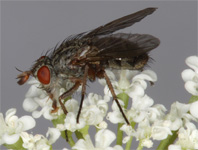Abstract
We report on the first records of Kiyohimea usagi Matsumoto & Robison 1992 (Ctenophora; Eurhamphaeidae) in the Atlantic Ocean. This large, fragile ctenophore cannot be captured by nets, and can only be studied in its natural habitat, the pelagic ocean. In the eastern Atlantic, in the Cape Verde region, in situ observations were obtained using the manned submersible JAGO and a towed pelagic observation system. Between 2015 and 2018 we documented 10 individuals which were encountered between 47–590 m depth. A description of the gastrovascular canal system is provided and potential feeding behavior is discussed. Our study confirms how in situ observations in the poorly explored pelagic realm will lead to the discovery of relatively large and previously undocumented fauna.
References
Choy, C.A., Haddock, S.H.D. & Robison, B.H. (2017) Deep pelagic food web structure as revealed by in situ feeding observations. Proceedings of the Royal Society B Biological Sciences, 284, 1869.
https://doi.org/10.1098/rspb.2017.2116
Christiansen, S., Hoving, H.J.T., Schütte, F., Hauss, H., Karstensen, J. Körtzinger, A., Schröder, M., Stemmann, L., Christiansen, B., Picheral, M., Brandt, P., Robison, B.H., Koch, R., Kiko, R. (2018) Particulate matter flux interception in oceanic mesoscale eddies by the polychaete Poeobius sp. Limnology and Oceanography, 63 (5), 2093–2109.
https://doi.org/10.1002/lno.10926
Haddock, S.H.D. (2004) A golden age of gelata: past and future research on planktonic ctenophores and cnidarians. Hydrobiologia, 530, 549–556.
https://doi.org/10.1007/s10750-004-2653-9
Haddock, S.H.D. (2007) Comparative feeding behavior of planktonic ctenophores. Integrative and Comparative Biology, 47, 847–853.
https://doi.org/10.1093/icb/icm088
Hamner, W.M., Madin, L.P., Alldredge, A.L., Gilmer, R.M. & Hamner, P.P. (1975) Underwater observations of gelatinous zooplankton: sampling problems, feeding biology and behavior. Limnology and Oceanography, 20, 907–917.
https://doi.org/10.4319/lo.1975.20.6.0907
Harbison, G.R. (1986) Toward a study of the biogeography of the pelagic ctenophores. In: Pierrot-Bults, A.C., van der Spoel, S., Zahuranec, B.J. & Johnson, R.K. (Eds.), Pelagic Biogeography. UNESCO Technical Papers in Marine Science, 49, pp. 112–117.
Hissmann, K. & Schauer, J. (2017) Manned submersible “JAGO.” Journal of large-scale Research Facilities, 3, 1–12. [GEOMAR Helmholtz-Zentrum für Ozeanforschung]
https://doi.org/10.17815/jlsrf-3-157
Javidpour, J., Molinero, J.C., Peschutter, J. & Sommer, U. (2009) Seasonal changes and population dynamics of the ctenophore Mnemiopsis leidyi after its first year of invasion in the Kiel Fjord, Western Baltic Sea. Biological Invasions, 11, 873–882.
https://doi.org/10.1007/s10530-008-9300-8
Komai, T. & Tokioka, T. (1940) Kiyohimea aurita, N. GN., SP., Type of a new family of Lobate Ctenophora. Annotationes Zoologicae Japonenses, 19, 43–46.
Kubota, S., Akiyama, H. & Yamasaki, Y. (2008) Second record of the ctenophore Kiyohimea aurita (Ctenophora, Tentaculata, Cydippida, Kiyohimeidae) in Japan. Bulletin of the Biogeographical Society of Japan, 63, 129–131.
Matsumoto, G.I. & Robison, B.H. (1992) Kiyohimea usagi, a new species of lobate ctenophore from the Monterey Submarine Canyon. Bulletin of Marine Science, 51, 19–29.
Robison, B.H. (2004) Deep pelagic biology. Journal of experimental marine biology and ecology, 300, 253–272.
https://doi.org/10.1016/j.jembe.2004.01.012
Robison, B.H. Reisenbichler, K.R. & Sherlock, R.E. (2005) Giant Larvacean Houses: Rapid Carbon Transport to the Deep Sea Floor. Science, 308, 1609–1611.
https://doi.org/10.1126/science.1109104
Sullivan, L.J. & Gifford, D.J. (2009) Preservation of the larval ctenophore Mnemiopsis leidyi A. agassiz (ctenophora, lobata). Journal of Plankton Research, 31, 921–926.
https://doi.org/10.1093/plankt/fbp031
Swift, H.F., Hamner, W.M., Robison, B.H. & Madin, L.P. (2009) Feeding behavior of the ctenophore Thalassocalyce inconstans: Revision of anatomy of the order Thalassocalycida. Marine Biology, 156, 1049–1056.
https://doi.org/10.1007/s00227-009-1149-6
Thibault-Botha D. & Bowen, T. (2004) Impact of formalin preservation on Pleurobrachia bachei (Ctenophora). Journal of Experimental Marine Biology and Ecology, 303, 11–17.
https://doi.org/10.1016/j.jembe.2003.10.017
Werner, T & Buchholz, F. (2013) Diel vertical migration behaviour in euphausiids of the northern Benguela current: Seasonal adaptations to food availability and strong gradients of temperature and oxygen. Journal of Plankton Research, 35, 792–812.
https://doi.org/10.1093/plankt/fbt030

